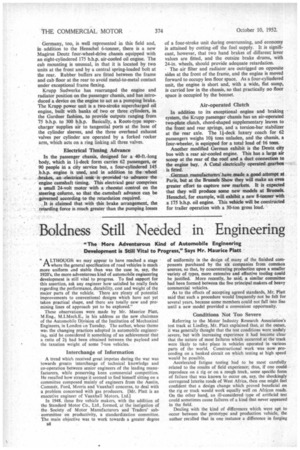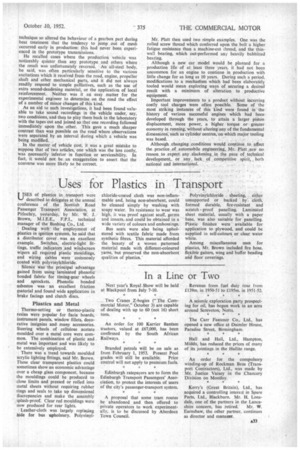Boldness Still Needed in Engineering
Page 42

Page 43

If you've noticed an error in this article please click here to report it so we can fix it.
"The More Adventurous Kind of Automobile Engineering Development is Still Vital to Progress," Says Mr. Maurice Platt
"ALTHOUGH we may appear to have reached a stage
where the general specification of road vehicles is much more uniform and stable than was the case in, say, the 1920's, the more adventurous kind of automobile engineering development is still vital to progress. To find support for this assertion, ask any engineer how satisfied he really feels regarding the performance, durability, cost and weight of the major parts of the vehicle. There are plenty of potential improvements to conventional designs which have not yet taken practical shape, and there are totally new and promising lines of approach yet to be explored."
These observations were made by Mr. Maurice Platt, M.Eng., M.I.Mech.E., in his address as the new chairman of the Automobile Division of the Institution of Mechanical Engineers, in London on Tuesday. The author, whose theme was the changing practices adopted in automobile engineering, said he considered it something of an achievement that a ratio of 21 had been obtained between the payload and the taxation weight of some 7-ton vehicles.
Interchange of Information A trend which received great impetus during the war was towards greatei interchange of technical knowledge and co-operation between senior engineers of the leading manufacturers, while preserving keen commercial competition. He recalled how strange it seemed to find himself sitting on a committee composed mainly of engineers from the Austin, Commer, Ford, Morris and Vauxhall concerns, to deal with a problem concerned with 'gas producers. [Mr. Platt is an executive engineer of Vauxhall Motors, Ltd.]
In 1948. these five vehicle makers, with the addition of the Standard Motor Co., Ltd., formed, at the instigation of the Society of Motor Manufacturers and Traders' subcommittee on productivity, a standardization committee. The main objective was to work towards a greater degree 58
of uniformity in the design of many of the finished components purchased by the six companies from common sources, so that, by concentrating production upon a smaller variety of types, more extensive and effective tooling could be justified. More recently, he said, a similar committee had been formed between the five principal makers of heavy commercial vehicles.
As to the effects of accepting agreed standards, Mr. Platt said that such a procedure would frequently not be felt for several years, because some members could not fall into line until a new model provided a convenient opportunity.
Conditions Not Too Severe
Referring to the Motor Industry Research Association's test track at Lindley, Mr. Platt explained that, at the outset, it was generally thought that the test conditions were unduly severe, but with increasing experience it had become clear that the nature of most failures which occurred at the track were likely to take place in vehicles operated in various parts of the world. Constructional work was now proceeding on a banked circuit on which testing at high speed would be possible.
Accelerated fatigue testing had to be most carefully related to the results of field experience; thus, if one could reproduce on a rig or on a rough track, some specific form of failure that was known to occur on, say, the shockingly corrugated laterite roads of West Africa, then one might feel confident that a design change which proved beneficial on the rig or track would work equally well on African roads. On the other hand, an ill-considered type of artificial test could sometimes cause failures of a kind that never appeared in the field.
Dealing with the kind of differences which were apt to occur between the prototype and production vehicle, the author recalled that in one instance a difference in forging technique so altered the behaviour of a gearbox part during heat treatment that the tendency to jump out of mesh occurred early in production: this had never been experienced in the prototype transmissions.
He recalled cases where the production vehicle was noticeably quieter than any prototype and others where the result was unfortunately reversed. An all-steel body, he said, was often particularly sensitive to the various excitations which it received from the road, engine. propeller shaft and other mechanical parts, and it did not always readily respond to simple palliatives. such as the use of extra sound-deadening material, or the application of local reinforcement. Neither was it an easy matter for the experimental engineer to determine on the road the effect of a number of minor changes of this kind.
As an aid to such investigations, it had been found valuable to take sound recordings in the vehicle under, say, two conditions, and then to play them back in the laboratory with the tapes cut and joined so that one recording followed immediately upon the other. This gave a much sharper contrast than was possible on the road where observations were separated by an interval during which a vehicle was being modified.
In the matter of vehicle cost, it was a great mistake to suppose that of two articles, one which was the less costly, was necessarily inferior in function or serviceability. In fact, it would not be an exaggeration to assert that the converse was more likely to be correct. Mr. Platt then used two simple examples. One was the rolled screw thread which conferred upon the bolt a higher fatigue resistance than a machine-cut thread, and the thinwall bearing, which out-performed any heavily babbitted bearing.
Although a new car model would be planned for a production life of at least three years. it had not been uncommon for an engine to continue in production with little change for as long as 10 years. During such a period, modifications to a mechanism which had been elaborately tooled would mean exploring ways of securing a desired result with a minimum of alteration to productive equipment.
Important improvements to a product without incurring costly tool charges were often possible. Some of the most striking instances of this kind were found in the history of various successful engines which had been developed through the years, to attain a larger piston displacement, more power, a higher torque or greater economy in running, without altering any of the fundamental dimensions, such as cylinder centres, on which major tooling was based.
Although changing conditions would continue to affect the practice of automobile engineering, Mr. Platt saw no reason to expect any slackening in the pace of technical development, or any, lack of competitive spirit, both national and international.












































































